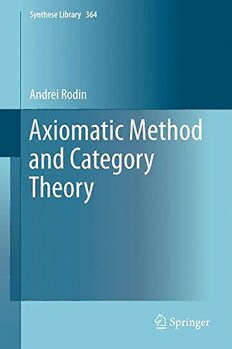Table Of ContentSynthese Library 364
Andrei Rodin
Axiomatic Method
and Category
Theory
Axiomatic Method and Category Theory
SYNTHESE LIBRARY
STUDIESINEPISTEMOLOGY,
LOGIC,METHODOLOGY,ANDPHILOSOPHYOFSCIENCE
Editors-in-Chief:
VINCENTF.HENDRICKS,UniversityofCopenhagen,Denmark
JOHNSYMONS,UniversityofTexasatElPaso,U.S.A.
HonoraryEditor:
JAAKKOHINTIKKA,BostonUniversity,U.S.A.
Editors:
DIRKVANDALEN,UniversityofUtrecht,TheNetherlands
THEOA.F.KUIPERS,UniversityofGroningen,TheNetherlands
TEDDYSEIDENFELD,CarnegieMellonUniversity,U.S.A.
PATRICKSUPPES,StanfordUniversity,California,U.S.A.
JANWOLEN´SKI,JagiellonianUniversity,Krako´w,Poland
VOLUME364
Forfurthervolumes:
http://www.springer.com/series/6607
Andrei Rodin
Axiomatic Method
and Category Theory
123
AndreiRodin
InstituteofPhilosophy
RussianAcademyofSciences
DepartmentofLiberalArts
StateUniversityofSaint-Petersburg
Saint-Petersburg
Russia
ISBN978-3-319-00403-7 ISBN978-3-319-00404-4(eBook)
DOI10.1007/978-3-319-00404-4
SpringerChamHeidelbergNewYorkDordrechtLondon
LibraryofCongressControlNumber:2013950616
©SpringerInternationalPublishingSwitzerland2014
Thisworkissubjecttocopyright.AllrightsarereservedbythePublisher,whetherthewholeorpartof
thematerialisconcerned,specificallytherightsoftranslation,reprinting,reuseofillustrations,recitation,
broadcasting,reproductiononmicrofilmsorinanyotherphysicalway,andtransmissionorinformation
storageandretrieval,electronicadaptation,computersoftware,orbysimilarordissimilarmethodology
nowknownorhereafterdeveloped.Exemptedfromthislegalreservationarebriefexcerptsinconnection
with reviews or scholarly analysis or material supplied specifically for the purpose of being entered
and executed on a computer system, for exclusive use by the purchaser of the work. Duplication of
this publication or parts thereof is permitted only under the provisions of the Copyright Law of the
Publisher’slocation,initscurrentversion,andpermissionforusemustalwaysbeobtainedfromSpringer.
PermissionsforusemaybeobtainedthroughRightsLinkattheCopyrightClearanceCenter.Violations
areliabletoprosecutionundertherespectiveCopyrightLaw.
Theuseofgeneraldescriptivenames,registerednames,trademarks,servicemarks,etc.inthispublication
doesnotimply,evenintheabsenceofaspecificstatement,thatsuchnamesareexemptfromtherelevant
protectivelawsandregulationsandthereforefreeforgeneraluse.
While the advice and information in this book are believed to be true and accurate at the date of
publication,neithertheauthorsnortheeditorsnorthepublishercanacceptanylegalresponsibilityfor
anyerrorsoromissionsthatmaybemade.Thepublishermakesnowarranty,expressorimplied,with
respecttothematerialcontainedherein.
Printedonacid-freepaper
SpringerispartofSpringerScience+BusinessMedia(www.springer.com)
Preface
Ifirstlearnedaboutcategorytheoryabout20yearsagofromYuriI.Manin’scourse
on algebraic geometry (Manin 1970) when I was preparing my dissertation on
Euclid’s Elements and was focused on studying Greek mathematics and classical
Greekphilosophy.ThenIconvincedmyselfthatthemathematicalcategorytheory
is philosophically relevant not only because of its name but also because of its
content and because of its special role in the contemporary mathematics, which I
privately compared to the role of the notion of figure in Euclid’s geometry. Today
I have more to say about these matters. The broad historical and philosophical
context,inwhichIstudiedcategorytheory,ismadeexplicitthroughoutthepresent
book. My interest to the Axiomatic Method stems from my work on Euclid and
extends through Hilbert and axiomatic set theories to Lawvere’s axiomatic topos
theorytotheUnivalentFoundationsofmathematicsrecentlyproposedbyVladimir
Voevodsky. This explains what the two subjects appearing in the titleof this book
shareincommon.
The next crucial biographical episode took place in 1999 when I was a young
scholarvisitingColumbiaUniversityontheFulbrightgrantworkingonontologyof
eventsunderthesupervisionofAchilleVarzi.AsapartofmyFulbrightprogramI
hadtomakeapresentationinadifferentAmericanuniversity,andIdecidedtouse
thisopportunityfortalkingaboutthephilosophicalsignificanceofcategorytheory
(I cannot now remember how exactly I married then this subject with the event
ontology).AchilleVarzikindlyarrangedformetheinvitationfromBarrySmithto
giveatalkathisseminaronformalontologyintheSUNYinBuffalo.WhenIsentto
BarrySmithmyabstractherepliedthatnobodyexceptprobablyBillLawverewill
beabletounderstandmypaper,andsuggestedtomakethepapermoreaccessibleto
thegeneralaudience.BythattimeIhadalreadyreadsomeofLawvere’spapersbut
waswhollyunawareaboutthefactthatLawvereworkedinthesameuniversityand
couldattendmyplannedtalk.SoItookSmith’swordsforajoke.WhenIrealized
thatthiswasnotajokeIwasveryexcitedand,asitturnedout,notwithoutareason
v
vi Preface
becausemymeetingwithLawvereduringthisvisitindeeddeterminedthedirection
of my research for many years to come. This book is a summary of what I have
achievedsofarworkinginthisdirection.
Saint-Petersburg,Russia AndreiRodin
Acknowledgement
My main intellectual debt is to Bill Lawvere. I am also very grateful to all
those friends and colleagues with whom I discussed the content of this book
at various occasions and who gave me valuable advices and opportunities for
its presentation. Leaving too many people out I mention Samson Abramsky,
Vladimir Arshinov, Sergei Artemov, Mark van Atten, Steven Awodey, Andrej
Bauer, Jean Be´nabou, Jean-Yves Be´ziau, Olivia Caramello, Pierre Cartier, Tatiana
Chernigovskaya,AnatolyChussov,BobCoecke,MaximDjomin,AndreasDo¨ring,
Haim Gaifman, Rene´ Guitart, Brice Halimi, Geoffrey Hellman, Jaakko Hintikka,
Christian Houzel, Daniel Isaacson, Valery Khakhanjan, Anatole Khelif, Anders
Kock, Roman Kossak, Anatoly Kritchevets, Marc Lachieze-Rey, Michiel van
Lambalgen, Vladislav Lektorsky, Elena Mamchur, Yuri Manin, Per Martin-Lo¨f,
Jean-Pierre Marquis, Fred Muller, John Mayberry, Colin McLarty, Arkady Nedel,
Marco Panza, Vasily Perminov, Alberto Peruzzi, Richard Pettigrew, Alain Proute´,
Oleg Prozorov, David Rabouin, Mehrnoosh Sadrzadeh, Gabriel Sandu, Dirk
Schlimm, Valdislav Shaposhnikov, Ivahn Smadja, Sergei Soloviev, John Stachel,
Jean-JacquesSzczeciniarz,AchilleVarzi,VladimirVasyukov,VladimirVoevodsky,
Michael Wright and Noson Yanofsky. My special personal debt is to Marina
Kravtsovawithoutwhosemoralsupportthisworkcouldnotbecompleted.
vii
Contents
1 Introduction................................................................. 1
PartI ABriefHistoryoftheAxiomaticMethod
2 Euclid:DoingandShowing................................................ 15
2.1 Demonstrationand“Monstration”................................... 16
2.2 AreEuclid’sProofsLogical?........................................ 19
2.3 Instantiation,ObjecthoodandObjectivity .......................... 23
2.4 Proto-LogicalDeductionandGeometricalProduction............. 27
2.5 EuclidandModernMathematics.................................... 35
3 Hilbert:MakingItFormal ................................................ 39
3.1 Foundationsof1899:LogicalFormandMathematicalIntuition.. 40
3.2 Foundationsof1899:LogicalityandLogicism..................... 47
3.3 AxiomatizationofLogic:LogicalFormVersusSymbolicForm .. 54
3.4 Foundationsof1927:IntuitionStrikesBack........................ 60
3.5 SymbolicLogicandDiagrammaticLogic .......................... 64
3.6 Foundationsof1934–1939:DoingIsShowing?.................... 68
4 FormalAxiomaticMethodandtheTwentiethCenturyMathematics 73
4.1 SetTheory............................................................ 74
4.2 Bourbaki.............................................................. 78
4.3 GalileanScienceandSet-TheoreticFoundationsofMathematics. 87
4.4 TowardstheNewAxiomaticMethod:InterpretingLogic.......... 93
5 Lawvere:PursuitofObjectivity .......................................... 99
5.1 ElementaryTheoryoftheCategoryofSets......................... 104
5.2 CategoryofCategoriesasaFoundation............................. 105
5.3 ConceptualTheoriesandTheirPresentations....................... 110
5.4 Curry-HowardCorrespondenceandCartesianClosedCategories. 118
5.5 Hyperdoctrines ....................................................... 122
5.6 FunctorialSemantics................................................. 125
ix

